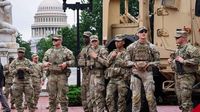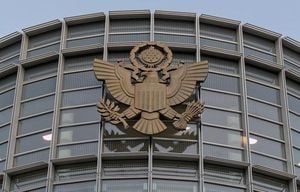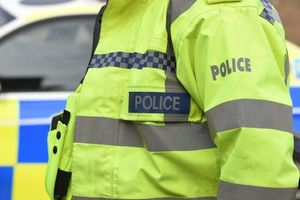With the iconic dome of the U.S. Capitol looming in the background, Washington, D.C. has found itself at the center of a sweeping federal law enforcement operation ordered by President Donald Trump. The city, long known for its vibrant neighborhoods and political activism, now feels transformed—some say occupied—as nearly 1,900 National Guard troops and hundreds of federal agents patrol the streets, man checkpoints, and enforce new measures aimed at curbing crime and illegal immigration.
The dramatic escalation began on August 7, 2025, when Trump initiated a surge of federal agents into the nation’s capital. Just days later, on August 11, he seized control of the D.C. police department, a move that sent shockwaves through the city’s leadership and its residents. By August 19, the president had ordered an even greater federal law enforcement presence, with the National Guard and federal officers from agencies like the Drug Enforcement Administration and Immigration and Customs Enforcement (ICE) deployed throughout key downtown areas, including the National Mall and major metro stations, according to Reuters and Yonhap.
As the crackdown intensified, Vice President JD Vance and Defense Secretary Pete Hegseth made a highly publicized visit to troops stationed at Union Station on August 20. Sharing burgers with soldiers at the bustling Shake Shack, Vance offered words of encouragement: “You guys are doing a hell of a job.” The visit, however, was not without controversy. Protestors gathered nearby, chanting “free D.C.” and voicing their opposition to what many perceive as an occupation. When confronted by a heckler, Vance retorted, “This is the guy who thinks people don’t deserve law and order in their own community.”
Trump himself announced plans to join an evening patrol with police and the military on August 21, telling conservative commentator Todd Starnes, “I'm going to be going out tonight with the police and with the military.” The president’s personal involvement underscored the administration’s commitment to a show of force in the Democratic-led city—a stance that has both supporters and detractors.
For some Washingtonians, the increased federal presence brings a sense of security. Others, however, feel under siege. According to Korea JoongAng Daily, crowds in neighborhoods like Columbia Heights have jeered at federal officers, and residents have begun sharing sightings of immigration agents to help migrants avoid arrest. The tension boiled over in the Columbia Heights neighborhood, where people banged pots and pans in defiance, and at a football game where spectators chanted “free D.C.”
The crackdown has not been without incident. On August 20, less than a mile from the Capitol, an armored National Guard vehicle—designed for war zones—collided with a civilian SUV, trapping the driver until emergency crews arrived. Bystanders gathered at the scene, with one woman shouting at the troops, “You come to our city and this is what you do? Seriously?” The event, captured on video, quickly spread online, fueling further frustration.
Federal officers have also been involved in removing protest banners, as seen in the Mount Pleasant neighborhood, where masked agents took down a profane sign. The administration posted a video of the incident, with an agent proclaiming, “We're taking America back, baby.” This, according to local resident Corey Frayer, “sends a message.” He added, “Mount Pleasant has always been a very activist, outspoken neighborhood. And I think they think if they can show up here and scare us, then they’ll have done their job.”
Immigration enforcement has become a central feature of the operation. Since the federal surge began, checkpoints have proliferated across the city. On August 21, U.S. Park Police stopped commercial vehicles in Rock Creek Park, checking licenses and insurance, before ICE agents questioned occupants about their immigration status. Martin Romero, a construction worker, described the scene: “We just came here to work. We aren't doing anything bad.” Two of Romero’s colleagues were detained, and he was left wondering about their fate. “They wouldn’t say where they're taking them or if they'll be able to come back.”
According to the White House, there have been 630 arrests since August 7, including 251 people identified as being in the country illegally. The overall number of people booked into the city jail has jumped by about 20 percent in the first ten days after the federal surge, averaging 78 bookings per day compared to 64 previously. These figures do not include immigration arrests, but do account for both local police and federal officer bookings, as reported by law enforcement officials.
City officials and experts have raised concerns about the constitutionality and effectiveness of the measures. D.C. Mayor Muriel Bowser has been openly critical, stating, “I don’t think you should have an armed militia in the nation’s capital.” She also objected to officers wearing masks and the use of the National Guard for law enforcement. Bowser acknowledged the proliferation of traffic checkpoints, attributing them to the surge of federal officers. “The surge of federal officers is allowing for different types of deployments, more frequent types of deployments, like checkpoints,” she said.
Legal scholars have weighed in as well. Jeffrey Bellin, a former prosecutor and professor at Vanderbilt Law School, noted that while the Supreme Court has upheld certain types of checkpoints—such as those for drunk driving or at the border—using them as a pretext for general crime control is constitutionally dubious. “The government can’t be constantly checking us and stopping to see if we're up to any criminal activity,” Bellin explained. Anthony Michael Kreis, a professor at Georgia State College of Law, added that the “arbitrary” and intrusive nature of the checkpoints could leave residents feeling aggrieved and suspicious.
Despite the administration’s claims of a crime crisis, city statistics show that crime was already on the decline before the federal intervention. Policing experts caution that a surge in law enforcement can sometimes simply relocate crime rather than prevent it, making it difficult to draw firm conclusions about the operation’s effectiveness.
The ripple effects of the crackdown have been felt in unexpected places. Daycare centers have partially closed or altered routines out of fear of federal agents. One administrator asked parents to keep their children at home, while others stopped taking kids on daily walks. The anxiety is palpable, especially among the city’s immigrant communities.
Meanwhile, the nation’s pop culture has not missed the opportunity to satirize the situation. The 27th-season premiere of the television show South Park lampooned the federal crackdown and President Trump, poking fun at the militarized atmosphere and the president’s persona in the show’s typically irreverent style.
As Washington braces for what could be a prolonged period of federal oversight, the city finds itself caught between competing visions of law, order, and civil liberty. Whether the president’s approach will be replicated in other cities—as he has suggested—or provoke a broader backlash remains to be seen. For now, the capital’s residents continue to navigate daily life amid armored vehicles, checkpoints, and the ever-watchful eyes of federal authorities.




